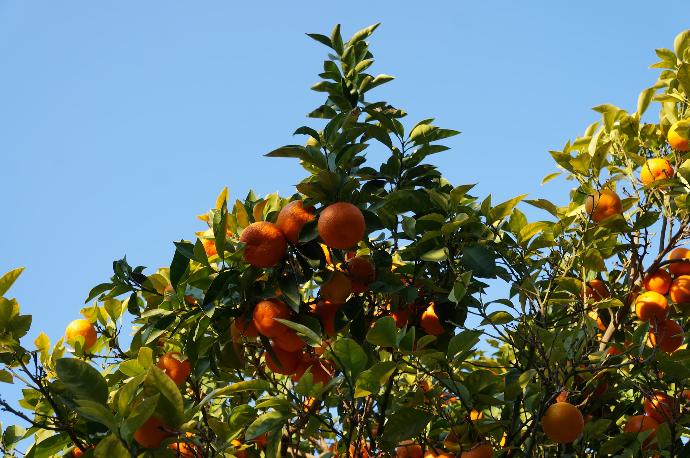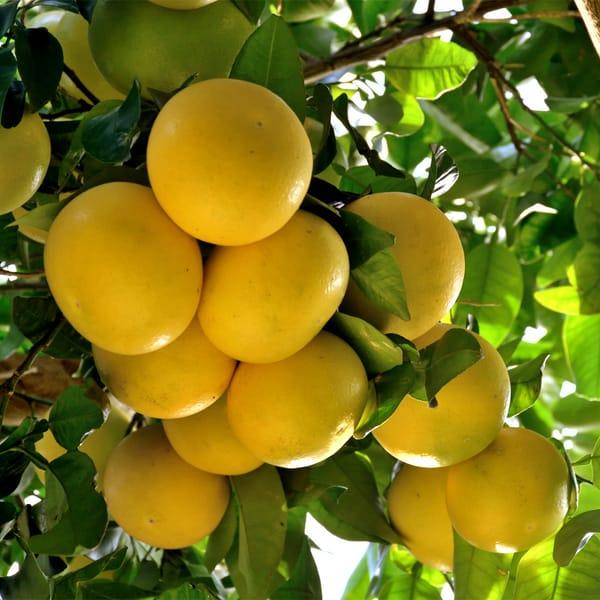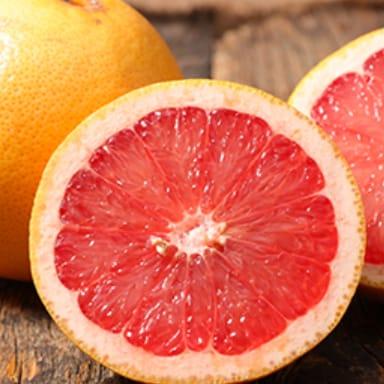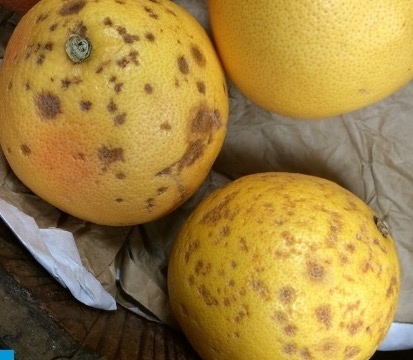Grapefruit
Grapefruit trees, 20-30 feet tall in Zones 9-11, grow rapidly in well-drained soil and full sun. Known for their large and tangy fruits, grapefruits are a popular citrus choice.

Habit
Tree
Height
3-5 m
Growth
Fast
Soil
Well-drained, loamy soil
Shade
Full Sun
Moisture
Moderate
Edible
Yes
Medicinal
Yes
Origin
Caribbean, USA
Climatic Condition
Subtropical, temperate
Temperature (°)
20-30°C
Humidity (%)
60-70%
Potting media
Well-draining mix
Fertilizers
Balanced fertilizer
Watering
Water regularly, requires full sunlight
Plant Weight
3-10 kg
Flowering Time
Winter to Spring
Soil Ph level
6.0 - 7.5
Water Ph level
6.0 - 7.0
Soil EC
0.3 - 0.5
Yield Per Plant
50-100 kg
NPK ratio
10:10:10
life Span
Perennial
Health Benefits
Known for its tangy, vitamin C-rich fruit.
Suggested Grow Media or Potting Mix ?
50% loam, 25% compost, 25% sand
Suggested Fertigation/Fertilizers
Fertilize every 6 weeks with a balanced citrus fertilizer.
Common Diseases and Remedies
Anthracnose , Scab .
Blackish sooty mould develops on leaves and fruits , fouled with honey dew , semi-translucent dot like lesions develops on leaves .
Proper and timely pruning , Remove and destroy infected fruits .
HEALTH BENEFITS
- Boosts metabolism: Known for aiding weight loss and digestion.
- Rich in vitamin C: Strengthens the immune system.
Supports heart health: Contains potassium and fiber, which benefit cardiovascular function.
What Is An Grape Fruit Tree ?
A grapefruit tree is a subtropical citrus tree known for its relatively large, sour to semi-sweet, somewhat bitter fruit. It is a hybrid of the sweet orange (Citrus sinensis) and the pomelo or shaddock (Citrus maxima), both of which were introduced from Asia in the 17th century. Grapefruit trees are typically evergreen, meaning they keep their leaves year-round. They can grow to be 15-20 feet tall and 10-15 feet wide. The leaves are dark green and glossy, and the flowers are white and fragrant. The fruit is round or slightly oblate, with a thick yellow or orange rind. The flesh inside is segmented and can be white, pink, or red. Grapefruit trees are grown commercially in many parts of the world, including the United States, Israel, Cyprus, South Africa, and Brazil. They are also a popular choice for home gardens in warm climates. If you're interested in growing your own grapefruit tree, be sure to choose a variety that is suited to your climate and growing conditions.

What Are The Different Types Of Grape Fruit Plants?
1. Pomelo
The grandparent of grapefruit, hailing from Southeast Asia. This giant citrus fruit possesses thick rinds and pale, mildly sweet flesh with a unique flavour.
2. Melogold
A hybrid of grapefruit and tangerine, offering a juicy, tangy-sweet flavour and a distinctive orange-yellow rind.
3. White or Yellow Grapefruit
The OG grapefruit, known for its intense tartness and pale yellow flesh. Think classic grapefruit juice with a pucker!
4. Pink Grapefruit
A sweeter and less acidic option compared to white grapefruit. Its vibrant pink flesh makes it a visually appealing choice.
5. Star Ruby or Ruby Red Grapefruit
The king of sweetness! This variety boasts deep red flesh and the least bitterness among grapefruits. Perfect for those who don't enjoy the grapefruit's signature tang.

How to care for Grape Fruit Plants ?
1. Location
Plant your tree in spring or fall in well-drained soil, at least 12 feet away from structures for mature size
2. Sunshine
Grapefruit trees thrive in full sun, needing at least 6-8 hours of direct sunlight daily. Choose a sheltered area protected from strong winds
3. Soil
Ensure good drainage with sandy-loam soil rich in organic matter. Amend heavy clay soil with sand or compost.
4. Hydration
Young trees: Water regularly, 1-3 times a week during the first year, especially in hot weather. Check the soil moisture and water deeply when the top inch feels dry. Established trees: Once established, reduce watering to weekly or whenever the top few inches of soil feel dry. Avoid overwatering, as it can lead to root rot. sand or compost.

5. Nourishment
Fertilizer: Feed your tree with a balanced citrus fertilizer 3 times a year - in January, May, and June. Follow the specific instructions on the chosen fertilizer.
6. Issues
Environmental Issues: Insufficient sunlight: This can lead to stunted growth, poor fruit production, and weak branches.
Overwatering or underwatering: Both can cause root rot, leaf drop, and stunted growth.
Nutrient deficiencies: Lack of essential nutrients like nitrogen, phosphorus, or potassium can affect growth, fruit production, and overall health.
Frost damage: Young trees are particularly vulnerable to frost, causing leaf and fruit damage.
What are the Benefits of Grape Fruit Tree ?
Delicious and nutritious: Grapefruit fruits are a rich source of vitamin C, fiber, and other essential nutrients, offering dietary benefits and contributing to a healthy lifestyle.
Variety of flavours and uses: With options ranging from tart to sweet, pink to white, and seeded to seedless, grapefruit caters to diverse palates and finds multiple uses, from fresh eating and juicing to culinary applications and desserts.
Potential health benefits: Research suggests consuming grapefruit might contribute to weight management, heart health, and immune system function. However, it's essential to consult a healthcare professional for personalized advice.

FAQs About Growing Grape Fruit
1. How to maintain Grapefruit Plants ?
Grapefruit trees are sun-worshippers! They need at least 6-8 hours of direct sunlight per day. Well-draining soil is crucial for grapefruit trees. Amend your soil with compost or sand if needed to ensure proper drainage. Feed your trees with a balanced citrus fertilizer three times a year: January, May, and June. Follow the application instructions on the fertilizer label carefully
2. What are the uses of grapefruit plants?
Fruit production , Fresh eating: The star of the show, grapefruit is enjoyed fresh for its refreshing taste, high vitamin C content, and potential health benefits. Squeezed for its tangy and nutritious juice, often consumed for breakfast or used in cocktails. Beyond simply eating it raw, grapefruit finds its way into various dishes like salads, marmalades, chutneys, and even desserts.
Beyond the fruit:
Ornamental value: Grapefruit trees have glossy green leaves and fragrant white blossoms, making them attractive additions to landscapes and gardens.
Essential oil: The peel and leaves can be processed for essential oil used in aromatherapy for its refreshing and potentially antiseptic properties.
Pectin: Found in the peel, pectin is a gelling agent used in jams, jellies, and other food applications.
Biofuel: Studies have explored the potential for using grapefruit waste to produce biofuel.
3. Can i grow grapefruit Indoors?
While growing grapefruit indoors is possible, it comes with certain challenges and requires specific conditions to be successful. Here's what you need to consider
Challenges:
Lighting: Grapefruit need 6-8 hours of direct sunlight daily. This can be difficult to achieve indoors, requiring artificial lighting supplementation.
Size: Mature grapefruit trees can reach significant heights (8-15 feet) and widths, potentially outgrowing indoor spaces. Dwarf varieties are available, but fruit production might be lower.
Fruiting: Indoor conditions may not perfectly mimic the ideal environment for consistent fruit production.
4. which pot is best for growing grapefruit?
The best pot for growing grapefruit depends on a few factors, including:
The size of your grapefruit tree: Grapefruit trees can grow quite large, even when container-grown. Choose a pot that is at least 50 centi-meters (20 inches) in diameter and depth for a young tree, and be prepared to repot it into a larger container every few years as it matures.
The material of the pot: Terracotta pots are a good choice for grapefruit trees because they allow the soil to dry out evenly and prevent root rot. However, they can be heavy and prone to cracking in cold weather. Plastic pots are lighter and more affordable, but they can retain moisture too well, so be sure to choose one with drainage holes. Wooden pots are also an option, but they need to be treated to prevent rot and decay.
5. From where can I shop for grapefruit?
Some near nurseries or groceries shops.


